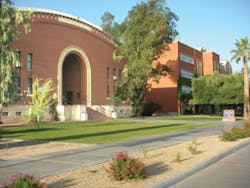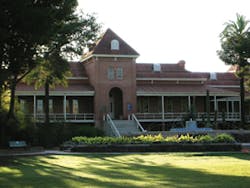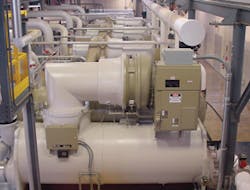In addition to better efficiency, cogeneration offers reliability and lifecycle cost advantages. Cogeneration is more reliable than merchant generators for electrical service, because it is committed exclusively to electrical needs of the customer. Source efficiency is improved, because cogeneration assets are in close proximity to where it is consumed, which dramatically minimizes the energy losses that are normally incurred in having to transport electricity over long distances. This efficiency is especially applicable for large consumers such as universities and hospitals, since they have a need for large amounts of heat most of the time.
Cogeneration designs that can effectively level the heat and power loads near full load are most ideal since turbines that operate near full load are more efficient. According to the California Energy Commission, “When less than full power is required from a gas turbine, the output is reduced by raising the turbine inlet temperature. In addition to reducing power, this change in operating conditions also reduces efficiency. Part-load efficiencies [50%] load are approximately 25% lower than full-load efficiencies.”
So, what can be done when heat and power loads are not level? This was the quandary faced by the University of Arizona, in Tucson, AZ. Five years ago, the University installed two very sophisticated and ambitious cogeneration plants. As the University expanded its campus, daytime electrical needs allowed full use of their solar gas-fired turbines, which in turn created sufficient heat during the day. At night, however, when the rest of the campus’s electrical requirements were reduced, the University Medical Center still needed heat for sterilization, laundry, and such. So, electricity was not only being produced under less-efficient conditions, two ancillary Rentech (2–50 kilobyte pounds per hour) boilers were needed to produce sufficient heat to meet hospital requirements. The innovative minds of senior staff technicians Gordon Bush and Marianne Deutsch, as well as Ned Morris, Trane senior sales engineer, rectified this dilemma. The mechanical, electric, and civil design was the responsibility of Henry Johnstone at GLHN Architects and Engineers. Together, they created a simple and innovative solution relative to this obvious waste.
Essentially, ice storage uses ice produced at night to cool buildings the following day. Ice storage serves the useful purpose of providing a nighttime load for the cogeneration plant (the ice-making chillers require electricity to operate), as well as to provide extra cooling capacity to meet cooling loads on the next day. Other unique benefits of ice storage include giving the University added flexibility during equipment downtime for scheduled chiller and turbine repair and maintenance.
Ice storage technology is both common and unique. It is common since it does for cooling what a domestic water heater does for hot water. As a unique cooling option, ice storage is the only air-conditioning system that utilizes plentiful nighttime-produced electricity to generate and store daytime cooling. As a result, it provides the key benefit of lowering greenhouse gas emissions, along with reducing the cost of cooling from on-peak electric demand. In utility-driven cooling applications, ice storage provides a nighttime electric load to store cooling. In the University of Arizona cogeneration application however, ice storage not only stores the cooling, it also provides a nighttime electric load in order to produce steam for use by the University Medical Center.
University of Arizona
With a student population of over 37,000 and supporting approximately 216 buildings on a 378-acre campus, the University facility infrastructure consists of three central plants: the Central Heating Refrigeration Plant (CHRP), the Central Refrigeration Building (CRB), and the Arizona Health Sciences Center (AHSC). These plants are hydraulically connected with all distribution and production controlled and optimized by a Trane Tracer Summit building automation system. This means that chilled water produced in any of the plants can be delivered to any corner of the campus.
The CHRP was built in 1950 and has 8,500 tons of centrifugal refrigeration chilled water capacity along with 154,000 pph of 125-psi steam
capacity from three gas-fired boilers. It also has a 6.5-MW, gas-fired turbine generator with an auxiliary 1.7-MW steam turbine generator that produces electricity for the campus grid, along with 33,000 pph of 125-psi steam from the Turbine Exhaust Heat Recovery Steam Generator (HRSG).
The second central plant, built in 1968, is the AHSC. It has 7,200 tons of centrifugal refrigeration chilled water capacity along with 70,000 pph of high-pressure steam capacity, which is produced by two gas-fired boilers and 24,000-pph-high-pressure steam from a 4.5-MW gas turbine at HRSG.
The CRB is of 1988 vintage and is the home of the Ice Storage System. When its three ice chillers make ice, the system has 15,650 tons of centrifugal refrigeration chilled water capacity. However, when the chillers produce chilled water, that capacity is increased to 17,000 tons.
The Ice Plant
“The ice storage system [also known as the thermal storage project or ice plant] is powered by a Combined Heat and Power [CHP] system located at the AHSC plant, that supplies electricity to three Trane CenTraVac ice chillers,” says Ned Morris Trane’s local representative. “These chillers make ice at 910 tons and 0.783 kilowatts per ton. They freeze water in the 156 storage tanks that are discharged on demand, providing 23,400-ton hours of capacity or 3,120 tons for 7.5 hours. We often accelerate the discharge to as high as 3,500 tons during peak hours, further reducing electric demand charges.”
The use of ice storage for recovering turbine heat means the AHSC Plant Turbine is now loaded during off-peak hours, thereby reducing the higher natural gas cost for boiler steam. In turn, chilled water costs are kept to a minimum by reducing the number of chillers that need to run at peak-demand periods.
When fully loaded, the Deltak Heat Recovery Steam Generator (22 KP pounds per hour) produces 24,000 pph of high-pressure steam, most of which is used by the AHSC, as well as by the University Medical Center and its surrounding buildings. The auxiliary steam turbine can be used to generate electricity during periods of excess steam production, if the chilled water load allows.
The ability to choose gas or purchased electricity, combined with the ability to move or reduce electric demand with ice storage, provides tremendous negotiating power with the local utility
suppliers.
Ice is produced at the CRB during the evening and at night, and is melted to produce chilled water during the day. However, during winter evenings when the campus chilled water load falls below 5,000 tons, the resultant electric load on the AHSC 4.5-MW solar turbine is unable to meet the University Medical Center and Sciences Center buildings’ steam demand. In these situations, the ice chillers are brought online to produce ice, raising the electrical load on the turbine, and thus producing the needed steam.
With 10 years of steady investment in chilled water distribution infrastructure, the University has created a chilled water grid with less than a 12-psig-pressure differential across the 1.3-mile campus diameter. As a result, chilled water produced by the ice storage system can be distributed across campus during the day to displace production by any chiller connected to the utility’s electrical grid and distribution loop. “Shaving this peak represents up to a $38,000 monthly savings to the University,” notes Deutsch.
In addition, prior to ice storage, the chillers needed to “cycle” in order to meet fluctuating cooling loads. With ice storage, the chillers can run constantly at the same level of output, which, in turn, optimizes the turbine’s efficiency and extends the life of the chillers.
University of Arizona representatives investigated ice storage by visiting several installations that use this technology, including CALMAC’s installation at Shell Point, a retirement community in Ft. Myers, FL. “Eventually the CALMAC system was chosen because of its tanks’ non-corrosive material, the ability to isolate modules in groups of three (IceBank tank model 1500C), the mobility of the tanks, their ease of installation, and the ease of maintenance and repair,” Bush. “An additional consideration was the simplicity and modular nature of the CALMAC system. We started on June 1, 2004 and produced our first batch of ice on July 1, 2004. We have had ice available everyday, without exception since then. We would not have made this tight schedule without our piping partner, Sun Mechanical, headed by Scott Candrian.”
The original plans called for 23,400 ton-hours (3,000 tons for eight hours at 39 degrees), however up to 23,400 ton-hours from the system at a higher discharge temperature for longer melting periods was delivered. Today, the system relies on 156 tanks at about 150 tons per hour each.
The original system has worked well, and there is a new project under construction. Another 49 tanks and a 1,250-ton Trane chiller were also ordered, for an increase of 7,350 ton-hours of ice storage at the CHRP. The 1,250-ton chiller can be used for both ice and chilled water generation.
University of Arizona’s decision to use ice storage involved many factors, including economical and environmental. While ice storage is generally touted as a cost-saving cooling option, in this instance, ice storage also provided the unique ability to dramatically increase cooling capacity, while improving the overall efficiency of the plant. To the University, these concerns were of paramount importance.
Ice storage also provides the University with greater flexibility in chiller and turbine maintenance scheduling, yet another benefit of base loading the turbine generation.
Ice Storage contributes to N+1 redundancy as well, an intrinsic concern for any engineer. While the University has sufficient capacity in place to meet its current daytime, peak-cooling load, ice storage serves in a standby capacity. Furthermore, should any chiller become inoperative, another chiller can be called into action without disruption to the service.
Computer-Modeled
“The efficient integration of all these loads could be a logistical nightmare,” explains Deutsch. “That’s why we recently installed highly sophisticated software to help optimize our energy consumption.” This software enables plant operators to monitor, control, and evaluate energy flows and costs.
The software creates up to 48 possible operating scenarios with different mixes of plants, chiller, boilers, pumps, towers, and ice storage. Operators can then choose the optimal scenario on the basis of cost, maintenance schedules, campus building schedules, and the weather forecast. “Ice storage has given us the flexibility we needed to maximize our efficiency with the production and use of energy,” adds Deutsch.
Saving energy, reducing costs, and lowering polluting emissions are an integral part of the University of Arizona’s mission of providing a comfortable, affordable learning experience for its students. The University facility managers are charged with maximizing the utilization of available resources and are committed to cogeneration. Challenged with having to provide heat to the hospital, they were also faced with having to cogenerate that heat. Ice storage met that requirement by consuming the cogenerated electricity, leveling the load, and improving efficiency and lowering emissions.How Ice Storage Works
The working principle of an ice storage system calls for chillers to make ice inside storage tanks during off-peak, nighttime hours when the energy is produced more efficiently, economically, and environmentally. Ice Storage uses the stored “thermal” energy of the ice to cool the buildings during the daytime peak-usage periods. This effectively shifts the electrical load off-peak, while avoiding higher-price energy and demand charges that are imposed by many utilities.The operation of an Ice Storage System is comprised of two normal modes: the ice charging mode and ice melt/burn mode.
During the ice charging mode, a designated ice-making chiller produces low temperature, 25% glycol solution that freezes the water inside an ice storage tank. This closed glycol loop consists of the ice storage cooling tanks, heat exchangers, and glycol pumps. The ice-charging mode continues until full ice capacity has been reached (usually about eight to 10 hours).
Initiated via an automated process, the ice melt mode begins when the temperature differential increases between the chilled water supply and the chilled water return. During the Ice Melt Mode, the chillers are either turned off or used to supplement the cooling requirements of the system.
The Benefits of Ice Storage Cooling
In many cases, ice storage allows for reducing the size of installed refrigeration capacity. For example, if the installed cost of the chiller is $600 per ton, every avoided ton of refrigeration capacity related to the installed ice storage system capacity saves $600. This assumes that the installation already has supporting chiller equipment in place, such as cooling towers and pumps. For a new installation, this amount can exceed $1,500 per ton, in which case the chiller plant size reduction can often completely offset the cost of storage.






